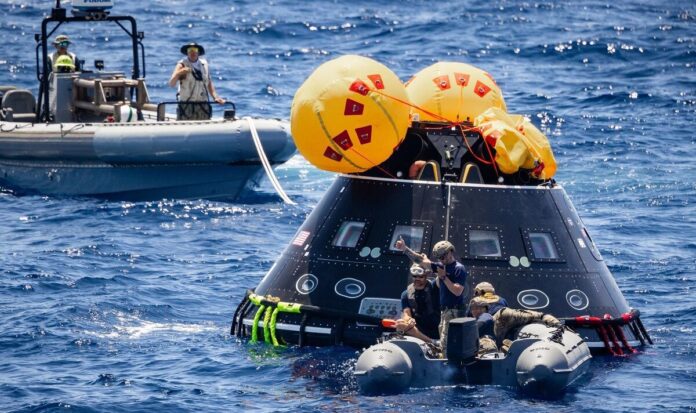NASA’s ‘search and rescue’ team is getting ready for the Artemis II splashdown (Image: NASA) As astronauts Victor Glover, Christina Hammock Koch, Jeremy Hansen and Reid Wiseman prepare to fly around the Moon next year, part of NASA is instead readying for their return. NASA’s Landing and Recovery team will be responsible for bringing the Orion capsule and its four crew members back to land after splashing down in the Pacific Ocean. And assisting will be the agency’s Search and Rescue office — a group which has spend more than 40 years assisting the International Cospas–Sarsat Program in developing new emergency communications technologies. These include radio distress beacons that allow hikers, sailors and pilots to transmit their location in the event of an emergency situation. Since 1982, this system has been responsible for helping save more than 50,000 explorers on Earth — and its successor might even come to the aid of the Artemis II astronauts too. Artemis II will carry its four-person crew more than 5,523 miles beyond the Moon (Image: NASA) Pictured: NASA, the Navy and the Air Force practice Artemis recovery procedures in the Pacific (Image: NASA) For the Artemis II mission, the Search and Rescue office will be installing second-generation, palm-sized ‘ANGEL’ beacons — Advanced Next-Generation Emergency Locator — in both the Orion capsule and each of the astronaut’s survival suits. In the event that the launch is aborted after take-off, or if the returning capsule ends up landing outside of the target splashdown zone, the ANGEL beacons will allow NASA to quickly locate the astronauts in the vastness of the Pacific. Alongside planning for these contingencies, Search and Rescue team members will also be on board the US Navy vessel tasked with recovering Orion, helping to track the spacecraft on the day that it makes its return to Earth. This feat will be accomplished using a piece of equipment dubbed the SAINT — the Search and Rescue Intelligent Terminal — which was successfully tested during the Artemis I mission back in December last year. And last month saw the Search and Rescue team onboard the USS John P. Murtha — a US Navy amphibious transport dock ship, named for the late Pennsylvania congressman — putting ANGEL and SAINT through their paces in readiness for next year’s launch. Cody Kelly and Thomas Montano of the Search and Rescue team showcase the ANGEL beacons (Image: NASA) Cody Kelly is NASA’s search and rescue manager for notional affairs at the agency’s Goddard Space Flight Center in Greenbelt, Maryland. He said: ‘Our role in human spaceflight across all of NASA’s crewed programs mirrors the daily work we do to support worldwide rescue, protecting those in distress in some of the world’s harshest conditions. ‘Our astronauts are one of our most valuable resources and everything we’ve done in the last few years with Orion and Artemis has been to make sure we can really embody the Artemis goals not just of exploration, but bringing the crew safely home. ‘The work we do is deeply personal. We know that it’s our friends and colleagues in that capsule and need to ensure they feel safe throughout their journey. ‘It is truly an honor and dream come true to be a small part of this large NASA effort.’ Pictured: Cody Kelly operating the SAINT application during the Artemis I splashdown (Image: Cody Kelly on the USS Portland operating the SAINT application during the Artemis I mission’s splash) Destined for a ten-day mission around the Moon and back, Artemis II is expected to blast off from the Kennedy Space Center in Florida in November next year. The flight will carry its four-person crew more than 5,523 miles beyond the Moon — further than any human has ever been from the Earth. Building on this, no earlier than 2025, the Artemis III mission will see four astronauts travel in an Orion capsule to the planned Lunar Gateway space station in the Moon’s orbit, spending a total of 30 days in space. Two of these explorers — including the first woman and person of color to walk on the Moon — will be carried down to the lunar surface by the Gateway’s ‘human landing system’. They will spend a week exploring the surface of the Moon’s South Pole — a region previously unvisited by humans. Here they will conduct various experiments, including the sampling of the water ice that was first detected on the lunar surface back in 1971. Follow our social media accounts on https://www.facebook.com/ExpressUSNews and @ExpressUSNews
NASA ‘search and rescue’ team readies for Artemis II mission splashdown
Sourceexpress.co.uk
RELATED ARTICLES


